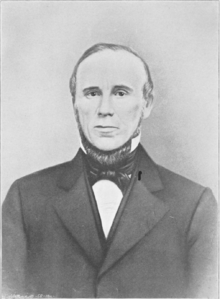Eclipse windmill
| Leonard Hemenway Wheeler | |
|---|---|
 |
|
| Born |
April 18, 1811 Shrewsbury, MA |
| Died | February 25, 1872 (aged 60) Beloit, WI |
| Occupation | Presbyterian Minister |
| Known for | Missionary among Ojibwe, windmill inventor |
The Eclipse windmill was one of the more successful designs of windmill used to pump water in the nineteenth century United States. It was invented by Leonard Wheeler, a Presbyterian minister who was working among the Ojibwe on the south shore of Lake Superior. Wheeler perfected the device on his missionary homestead for nearly two decades, unknown to the larger technological world. In 1866 health issues forced him to move to Beloit, Wisconsin, then a bustling industrial city, where he was persuaded to patent the basic function of the device. Although Wheeler died before he could witness the success of his invention, his sons carried on the legacy. Some of the companies that succeeded the original Eclipse Windmill Company remain viable in the 21st century.
Leonard Hemenway Wheeler was born in Shrewsbury, MA, on April 18, 1811. His mother died when he was one month old. He was raised by his father and an aunt in Bridport, VT. He attended college at Middlebury College, where he graduated in 1837, and Andover Theological Seminary, where he graduated in 1840. Around this time he met and married Harriet Wood, similarly devout in her religious beliefs. Since Leonard was already committed to missionary work among the Ojibwe, the couple soon found themselves setting up a household at La Pointe, Wisconsin on Madeline Island in Wisconsin Territory.
Wheeler eventually became committed to the notion of helping the Ojibwe learn the agricultural skills needed to sustain themselves, especially since the fur trade, upon which they had been economically dependent for several generations, was declining dramatically. The island was not conducive to farming, so Wheeler moved to the mainland, and established a home and mission, naming it Odanah, the Ojibwe word for village. Many Ojibwe (there were around 1000 in the Chequamegon Bay region) were already semi-permanent residents of that location, because of wild rice fields at the mouth of the Bad River. The Ojibwe name of the location was Kietiganing.
...
Wikipedia
